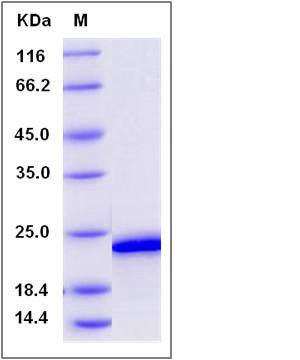Human FGF19 Protein
FGF19
- 100ug (NPP1280) Please inquiry
| Catalog Number | P12226-HNAE |
|---|---|
| Organism Species | Human |
| Host | E. coli |
| Synonyms | FGF19 |
| Molecular Weight | The recombinant human FGF19 consists of 191 amino acids and predicts a molecular mass of 21.4 KDa. It migrates as an approximately 23 KDa band in SDS-PAGE under reducing conditions. |
| predicted N | Met |
| SDS-PAGE |  |
| Purity | > 97 % as determined by SDS-PAGE |
| Protein Construction | A DNA sequence encoding the mature form of human FGF19 (O95750) (Phe27-Lys216) was expressed, with a N-terminal Met. |
| Bio-activity | |
| Research Area | Developmental Biology |Embryogenesis |Embryonic Stem Cells |Secreted |
| Formulation | Lyophilized from sterile 15% gly, 50mM Tris, 2mM EDTA 1. Normally 5 % - 8 % trehalose, mannitol and 0.01% Tween80 are added as protectants before lyophilization. Specific concentrations are included in the hardcopy of COA. |
| Background | FGF19, also known as FGF-19, is a member of the fibroblast growth factor (FGF) family. FGF family members possess broad mitogenic and cell survival activities, and are involved in a variety of biological processes, including embryonic development, cell growth, morphogenesis, tissue repair, tumor growth and invasion. FGF19 interacts with FGFR1, FGFR2, FGFR3 and FGFR4. Affinity between fibroblast growth factors (FGFs) and their receptors is increased by KL, KLB and heparan sulfate glycosaminoglycans that function as coreceptors. It interacts with KL and KLB directly. However, it interacts with FGFR4 in the presence of heparin, KL or KLB. FGF19 is involved in the suppression of bile acid biosynthesis through down-regulation of CYP7A1 expression, following positive regulation of the JNK and ERK1/2 cascades. It also stimulates glucose uptake in adipocytes. |
| Reference |
